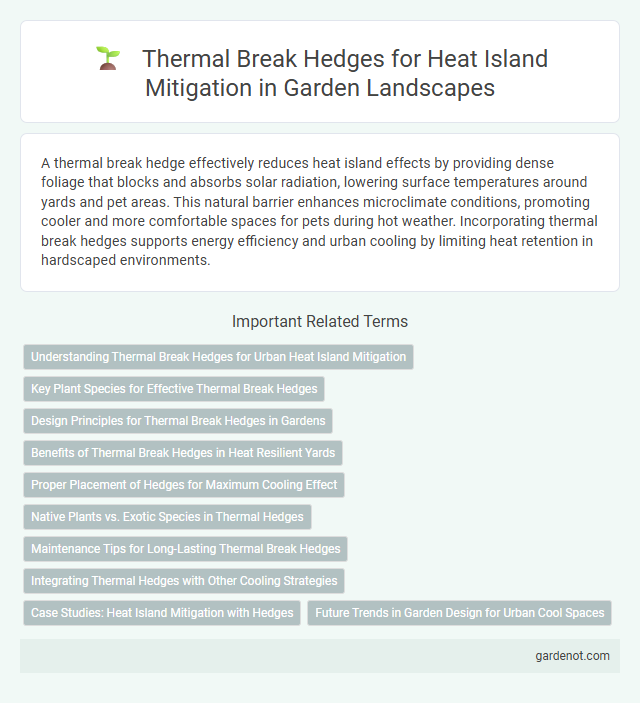A thermal break hedge effectively reduces heat island effects by providing dense foliage that blocks and absorbs solar radiation, lowering surface temperatures around yards and pet areas. This natural barrier enhances microclimate conditions, promoting cooler and more comfortable spaces for pets during hot weather. Incorporating thermal break hedges supports energy efficiency and urban cooling by limiting heat retention in hardscaped environments.
Understanding Thermal Break Hedges for Urban Heat Island Mitigation
Thermal break hedges are strategically planted vegetation barriers designed to reduce urban heat island effects by interrupting heat transfer between paved surfaces and surrounding air. These hedges enhance microclimate cooling through evapotranspiration and shading, lowering ambient temperatures and improving thermal comfort. Employing species with dense foliage and high transpiration rates maximizes their effectiveness in mitigating heat buildup in urban yards.
Key Plant Species for Effective Thermal Break Hedges
Key plant species for effective thermal break hedges include dense, evergreen shrubs like Boxwood (Buxus sempervirens), Privet (Ligustrum spp.), and Holly (Ilex spp.) that provide year-round foliage to reduce heat absorption. Deciduous species such as Eastern Redbud (Cercis canadensis) and Serviceberry (Amelanchier spp.) contribute seasonal shading and cool the surrounding microclimate during summer months. Integrating native grasses like Switchgrass (Panicum virgatum) enhances air circulation and supports biodiversity, optimizing the thermal break hedge's performance in heat island mitigation.
Design Principles for Thermal Break Hedges in Gardens
Thermal break hedges in gardens should be strategically positioned to maximize shading and wind reduction, effectively lowering surrounding temperatures and mitigating heat island effects. Selection of dense, evergreen plant species with high evapotranspiration rates enhances thermal insulation and air cooling. Proper spacing and layering within the hedge structure optimize air circulation, ensuring efficient temperature regulation and energy savings in adjacent outdoor spaces.
Benefits of Thermal Break Hedges in Heat Resilient Yards
Thermal break hedges significantly reduce surface and ambient temperatures by providing dense shading and disrupting heat transfer, enhancing heat resilience in urban yards. Their deep root systems improve soil moisture retention and promote cooler microclimates, lowering reliance on artificial cooling. These hedges also act as natural windbreaks, reducing heat buildup and contributing to sustainable, energy-efficient landscape designs.
Proper Placement of Hedges for Maximum Cooling Effect
Proper placement of thermal break hedges is essential for maximum cooling effect in heat island mitigation yards. Positioning hedges on the southern and western sides of buildings blocks direct solar radiation, reducing surface temperatures by up to 10degF. Strategic spacing of dense, evergreen species enhances airflow disruption, promoting natural cooling and lowering ambient air temperature around outdoor spaces.
Native Plants vs. Exotic Species in Thermal Hedges
Native plants in thermal break hedges offer superior heat island mitigation by providing dense foliage and deep root systems that enhance soil moisture retention and natural cooling. Exotic species often lack adaptability, leading to reduced resilience and less effective shading, which diminishes their thermal regulation capacity. Prioritizing native plants ensures sustainable thermal hedges that optimize microclimate cooling and support local biodiversity.
Maintenance Tips for Long-Lasting Thermal Break Hedges
Regular pruning and watering are essential to maintain the dense foliage of thermal break hedges, which enhances their effectiveness in heat island mitigation. Applying mulch around the base helps retain soil moisture and regulate temperature, promoting healthy root growth. Inspecting for pests and diseases early prevents damage that could reduce the hedge's insulating properties.
Integrating Thermal Hedges with Other Cooling Strategies
Integrating thermal break hedges with green roofs and reflective surfaces significantly enhances urban heat island mitigation by creating combined cooling effects that reduce surface temperatures and improve air quality. Thermal hedges act as natural insulation barriers, while green roofs contribute evapotranspiration cooling, and reflective surfaces minimize solar heat absorption. This multi-layered strategy maximizes energy efficiency and fosters sustainable urban microclimates.
Case Studies: Heat Island Mitigation with Hedges
Case studies on heat island mitigation with thermal break hedges demonstrate significant temperature reductions in urban areas by strategically planting dense, evergreen species that provide continuous shade and evapotranspiration cooling. Research shows thermal break hedges can lower surface temperatures by up to 4degC, improving pedestrian comfort and reducing building cooling loads. These findings highlight hedges as an effective natural solution for mitigating urban heat islands while enhancing green infrastructure.
Future Trends in Garden Design for Urban Cool Spaces
Thermal break hedges are emerging as a vital component in future urban garden designs for heat island mitigation, effectively reducing ambient temperatures by creating natural barriers that block and absorb heat. Incorporating drought-resistant and native plant species enhances sustainability while promoting biodiversity within city landscapes. Advances in smart irrigation and sensor technology optimize hedge health, ensuring consistent thermal performance in increasingly warm urban environments.
Thermal break hedge Infographic

 gardenot.com
gardenot.com